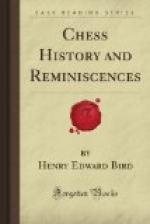“Let each player place his Elephant on the left of his King, next to that the Horse, and last of all the Ship, and in each of the four Armies, let the Infantry be drawn up in front. The Ship shall occupy the left hand corner next to it the Horse, then the Elephant, and lastly the King, the Foot Soldiers, as are stated being drawn up in front.”
The sage commences general directions for play with the following advice:
“Let each player preserve his own forces with excessive care, and remember that the King is the most important of all.”
The sage adds:
“O Prince, from inattention to the humbler forces the king himself may fall into disaster.”
“If, on throwing the die, the number should turn up five, the King or one of the Pawns must move; if four, the Elephant; if three, the Horse; and if the throw be two, then, O Prince, the Ship must move.”
------
ON THE MOVES OF THE PIECES
“The King moves one square in all directions; the Pawn moves one square straightforward, but smites an enemy through either angle, in advance; the Elephant, O Prince of many lands, moves, (so far as his path is clear), In the direction of the four cardinal points, according to his own pleasure. The Horse moves over the three squares in an oblique direction; and the Ship, O Yudhisthira, moves two squares diagonally.”
Note. The Elephant had the same move as our Rook has, the Horse the same as our Knight. The ship had two clear moves diagonally (a limited form of our Bishop). The King one square in all directions the same as now. The Pawn one square straightforward. There was no Queen in the Chaturanga, but a piece, with a one square move, existed in the two handed modified Chatrang. The Queen, of present powers is first mentioned in the game at the end of the 15th century, when the works of the Spanish writers Lucena and Vicenz appeared in 1495.
------
About two thousand six hundred years are supposed to have elapsed between the time of King Pandu, Prince Yudhisthira, Vyasa, and the records of the ancient Chaturanga, to the days of Alexander the Great, to which period the references concerning chess and the Indian Kings contained in Eastern accounts, Firdausi’s Persian Shahnama and the Asiatic Society’s M.S. presented to them by Major Price, relate.
Note. The Shahnama, it is recorded, occupied thirty years in its preparation and contains one hundred and twenty thousand verses.
The long interval of three or four thousand years, between the date ascribed to the Chaturanga, and its reappearance as the Chatrang in Persia, and the Shatranj in Arabia, has perplexed all writers, for none can offer a vestige of trace of evidence, either of the conversion of Chaturanga into Chatrang or Shatranj; or that the game ever continued to be practiced in its old form either with or without the dice, it is




